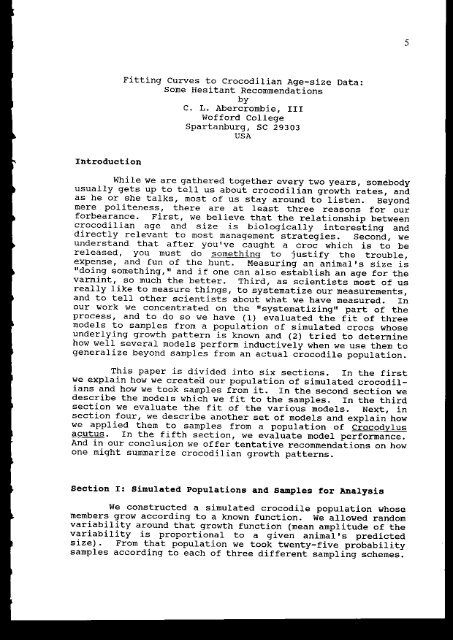size: 5036KB - Crocodile Specialist Group
size: 5036KB - Crocodile Specialist Group
size: 5036KB - Crocodile Specialist Group
You also want an ePaper? Increase the reach of your titles
YUMPU automatically turns print PDFs into web optimized ePapers that Google loves.
Fitting Curves to crocodilian Aqe-<strong>size</strong> Data:<br />
sone Hesitant Recommendal ions<br />
by<br />
C. L. Abercroirbie. III<br />
wofford College<br />
Spartanburg, SC 29303<br />
USA<br />
frrtroiluction<br />
While we are gathered together every tvro years, somebody<br />
usually gets up to tell us about crocodiltan growth rates, and<br />
as he or she tafks, most of us stay around to listen. Beyond<br />
nere politeness, there are at least three reasons for our<br />
forbearance. First, we believe that the relationship betr{reen<br />
crocodilian age and <strong>size</strong> is biologically interesling and<br />
directly relevant to most nanagement strategies. Second, we<br />
understand that after you've caught a croC which is to be<br />
released, you must do sonethinq to justify the trouble,<br />
expense, and fun of the hunt. Measuring an aninalrs <strong>size</strong> is<br />
rrdoing something," and if one can also es€ablish an age for the<br />
varhint, so nuch the better. Third, as scientists most of us<br />
really like to measure things, to systernatize our neasurenencs,<br />
and to te]1 other scientists about what we have neasured. In<br />
our vork rre concentrated on the t'systenatiz ingtr part of the<br />
process, and to do so r^re have (1) evaluated th; fit of three<br />
nodels to sanples from a population of sinulated crocs whose<br />
underlying growth pattern is known and (2) tried to deternine<br />
horat wefl severaf hodels perforrn inductively vhen we use then to<br />
generalize beyond sanples from an actual ciocodile population.<br />
This paper is divided into six sections. In the first<br />
ve explain how we createa our population of sirnulated crocodil_<br />
aans and how we took satmples froh it. In the second section we<br />
describe the rnodel s hrhich we fit to the samples. In the third<br />
section ve evaluate the fit of the variouJ rnodels. Next, in<br />
section four, we describe another set of models and explain how<br />
we applied then to sanples frorn a population of c;ocodvtus<br />
acutus. In the fj.fth section. we evaluate rnodel perfonnance.<br />
And in our concfusion we offer tentative recommendaiions on hovr<br />
one night sunlnarize crocodilian growth patterns.<br />
Section I! Sinulateal populatiorls anal gaDples for AnaLygis<br />
we constructed a simulated crocodile population whose<br />
nembers grow according to a known function. we;Ilornred random<br />
wariability around that qrowth function (rnean ahplitude of the<br />
variability is proportional to a given aniha-l,s predicted<br />
<strong>size</strong>). Frorn ttrat population we tooi trl'enty-five priUaUitity<br />
sanples according to each of three different sahpli;g schenes.
















